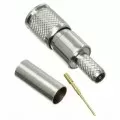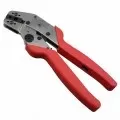OUTLINE:
Understanding the Coaxial Connector
 130
130A coaxial connector is a type of electrical connector designed for connecting coaxial cables, which are commonly used for transmitting radio frequency (RF) signals.
It typically consists of a center conductor surrounded by an insulating layer, a metallic shield, and an outer insulating layer.
Coaxial connectors are widely used in various applications such as telecommunications, cable television, networking, and instrumentation, providing a secure and reliable connection for transmitting high-frequency signals with minimal interference.

Image Source: connectorsupplier
What Is a Coaxial Connector Used for
A coaxial connector is primarily used for connecting coaxial cables, which are designed for transmitting high-frequency signals, particularly radio frequency (RF) signals.
These connectors are utilized in a wide range of applications across various industries, including:
Telecommunications: Coaxial connectors are commonly used in telecommunications systems for transmitting data, voice, and video signals over long distances.
They are integral components in networking equipment, satellite communication systems, and broadband internet connections.
Cable Television (CATV): Coaxial connectors play a crucial role in cable television systems for distributing television signals to households.
They connect coaxial cables from cable service providers to cable modems, set-top boxes, and television sets.
Broadcasting: In broadcasting applications, coaxial connectors are used to interconnect broadcasting equipment, such as antennas, transmitters, receivers, and studio equipment.
They ensure reliable signal transmission for radio and television broadcasting.
Wireless Communication: Coaxial connectors are essential in wireless communication systems, including cellular networks, Wi-Fi networks, and microwave communication systems.
They connect antennas, amplifiers, and other RF components to transmit and receive signals wirelessly.
Instrumentation: Coaxial connectors are widely used in instrumentation and measurement applications, such as oscilloscopes, spectrum analyzers, and signal generators.
They provide a reliable interface for connecting test equipment to devices under test (DUT).
Medical Equipment: Coaxial connectors are employed in medical equipment for diagnostic imaging, patient monitoring, and therapeutic applications.
They ensure the transmission of accurate and high-quality signals in medical devices such as MRI machines, ultrasound equipment, and patient monitoring systems.
Aerospace and Defense: Coaxial connectors are critical components in aerospace and defense systems, including radar systems, navigation systems, avionics, and military communications equipment.
They are designed to withstand harsh environmental conditions and ensure secure signal transmission in demanding applications.
Advantages and Disadvantages of Coaxial Connector
Advantages
High Frequency Capability: Coaxial connectors are designed to handle high-frequency signals efficiently, making them suitable for applications such as telecommunications, broadcasting, and wireless communication.
Low Signal Loss: Coaxial cables with proper shielding offer low signal loss, ensuring minimal attenuation over long cable runs. This makes coaxial connectors ideal for transmitting signals over considerable distances without significant degradation.
Shielding from Interference: The coaxial cable's shield provides excellent protection against electromagnetic interference (EMI) and radio frequency interference (RFI), ensuring reliable signal transmission even in noisy environments.
Secure Connection: Coaxial connectors feature a threaded coupling mechanism that provides a secure and robust connection, reducing the risk of signal interruption or disconnection due to vibrations or movements.
Versatility: Coaxial connectors come in various types and sizes, offering versatility to accommodate different cable sizes, frequency ranges, and applications. They can be used in a wide range of industries, including telecommunications, broadcasting, aerospace, and medical equipment.
Disadvantages of Coaxial Connector:
Limited Bandwidth: While coaxial connectors offer high-frequency capabilities, they may have limited bandwidth compared to other transmission mediums such as fiber optics.
This limitation can affect their suitability for extremely high-speed data transmission applications.
Bulkiness: Coaxial cables and connectors can be bulky compared to other types of cables, especially for high-frequency applications.
This bulkiness may pose challenges in installations where space is limited or where flexibility is required.
Cost: Coaxial connectors and cables, especially those designed for high-frequency applications, can be more expensive than other types of connectors and cables.
The cost of coaxial connectors may be a consideration for budget-conscious projects or applications.
Impedance Matching: Coaxial connectors require precise impedance matching between the cable and connectors to minimize signal reflections and ensure optimal performance.
Achieving proper impedance matching may require careful attention to cable lengths and connector specifications.
Susceptibility to Moisture: Coaxial connectors may be susceptible to moisture ingress, which can degrade signal quality and lead to corrosion over time.
Proper sealing and waterproofing measures are necessary to mitigate this risk, especially in outdoor or harsh environments.
What Are three 3 types of Coaxial Connectors
Three common types of coaxial connectors are:
1. BNC (Bayonet Neill-Concelman): BNC connectors are popular in applications where quick and secure connections are required, such as in telecommunications, test and measurement equipment, and video surveillance systems.
They feature a bayonet coupling mechanism that allows for fast and reliable connection by simply pushing and twisting the connector into place.
2. SMA (SubMiniature version A): SMA connectors are commonly used in high-frequency applications, particularly in RF and microwave systems.
They offer excellent performance at frequencies up to GHz ranges and are widely used in wireless communication systems, satellite communication, and instrumentation.
SMA connectors feature a threaded coupling mechanism for a secure and stable connection.
3. N-Type: N-type connectors are rugged and durable connectors suitable for applications requiring reliable signal transmission in harsh environments.
They offer low insertion loss and high power handling capabilities, making them ideal for use in aerospace, defense, and industrial applications.
N-type connectors feature a threaded coupling mechanism for secure mating and are available in various sizes to accommodate different cable types and frequency ranges.
What Is the Transmission Speed of Coaxial Connector
The transmission speed of coaxial connectors varies based on factors like cable type and application.
Standard coaxial cables (e.g., RG-6) typically support speeds ranging from Mbps to multiple Gbps, while specialized cables for RF and microwave systems can reach speeds of tens or even hundreds of Gbps.
Factors such as signal integrity and noise immunity also affect transmission speed.
Therefore, while coaxial connectors can handle high-speed data transmission, careful consideration of these factors is crucial for optimal performance in specific applications.
The End
In closing, "A Comprehensive Guide to Coaxial Connectors" serves as your indispensable companion in navigating the complexities of coaxial connectivity.
From unraveling the intricacies of different connector types to understanding their applications across various industries, this guide equips you with the knowledge and expertise to harness the full potential of coaxial connectors in your projects.
Whether you're an experienced engineer, a curious enthusiast, or a student embarking on a learning journey, may this guide empower you to make informed decisions and confidently integrate coaxial connectors into your designs.
As you embark on your exploration of coaxial connectivity, may this guide continue to serve as a valuable resource and companion, guiding you towards success in your endeavors.

Disclaimer: The views and opinions expressed by individual authors or forum participants on this website do not represent the views and opinions of Chipsmall, nor do they represent Chipsmall's official policy.

share this blog to:



